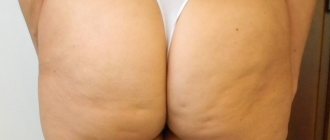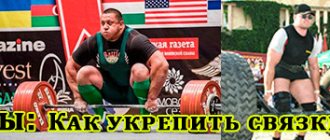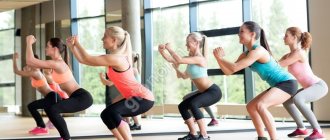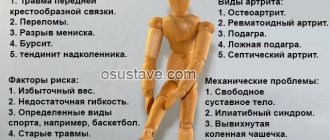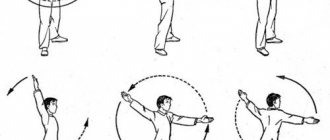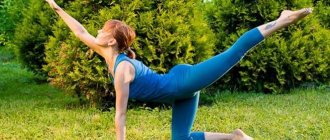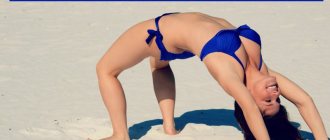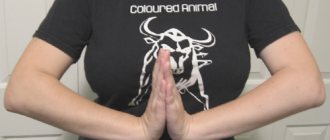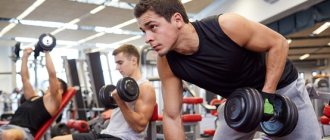March 18, 2020 Admin Home page » Important points of aerobics
How to improve joint function, types of joint exercises and their benefits for the body. Tips and recommendations from experts. Detailed video tutorials.
More and more often, recently, problems of the musculoskeletal system are beginning to fail, the main reason being a sedentary lifestyle, but increasingly this problem occurs in the young population, despite the fact that they are more or less active. Basically, the problem concerns the manifestation of pain in the lower back and knees, because basically the entire load falls on this area. It is for these purposes that joint exercises have been developed, protecting against extreme treatment - the use of drugs and surgical intervention.
Joint gymnastics - what is it?
The health of bones and joints is an issue that worries not only people of the older generation; arthritis, arthrosis and osteochondrosis have become noticeably “younger” today.
Professional athletes are well aware of problems with joints and the spine. Therefore, regular joint exercises will be useful for everyone who wants to maintain flexibility, mobility of joints and elasticity of ligaments and tendons. The main principle of exercises for joints is to perform movements smoothly, without jerking, in a mode that is comfortable for a person.
There is no burden, all movements are soft, twisting, pulling or rotating.
The secret of the benefits of joint gymnastics
Movement is the basis of every person’s life, so regular exercise will bring 100% benefits:
- joint fluid, a lubricant that makes joints mobile, is more actively produced - you become able to make movements that you could not even think about before, soreness in the joints goes away, they become more developed;
- Exercises that seem simple at first glance warm up all the muscles of the body - which means the mobility of the whole body increases together;
- Warm-up with elements of joint gymnastics is perfect for preparing for strength or cardio exercises;
- The risk of salt deposits on the affected joints is reduced;
- The musculoskeletal system is improved due to increased blood supply and saturation of cells with nutrients;
- A boost of energy and a feeling of vigor will be a pleasant addition, because physical activity activates the production of the happiness hormone;
- the functioning of the body's hormonal system improves.
The movements of joint gymnastics are easy and simple, do not require serious preparation and are suitable for people of all ages. At the same time, you will launch body renewal processes, strengthen muscles and ligaments, relieve fatigue and reduce the risk of serious diseases.
How to increase the effectiveness of training? Natural remedies for joint recovery
Bubnovsky’s joint gymnastics is an undoubtedly effective method, but it solves only specific problems, actually slowing down the course of the disease. Whereas to finally solve the problem, it is necessary to eliminate the factors that provoke it. In this regard, such natural remedies for joint restoration as Dandelion P , Dihydroquercetin Plus and Apitonus P .
Dandelion P is a natural chondroprotector that promotes the natural restoration of connective tissue in joints by stimulating the production of chondrocytes (cells that form cartilage).
Dihydroquercetin Plus is a powerful circulatory stimulant that improves the supply of oxygen and nutrients to joint tissue. The vitamin and mineral complex Apitonus P . In addition to dihydroquercetin, it contains royal jelly and bee pollen, which contain a colossal number of useful substances, including those necessary for nutrition and renewal of cartilage tissue.
We must also not forget that the main cause of most joint pathologies is a violation of metabolic processes in bone tissue. To solve this problem, Russian scientists have developed an innovative product Osteomed , which helps restore the natural mineral density of bones and eliminate destructive processes in joint tissues.
USEFUL TO KNOW:
ABOUT CALCIUM
Excess calcium in the body - how not to turn into stone
CALCIUMAuthor: admin1102.06.2020
Every schoolchild knows that calcium is needed for strong bones, teeth, hair and nails. Intrusive advertising on TV does not allow you to forget about this. Meanwhile, an excess of calcium in the body is a much more dangerous condition than a deficiency of the mineral. Don't believe me? Then look into your kettle. Do you see scale on its walls? The organs look roughly the same...
Read more
ABOUT HORMONE THERAPY
The power of hormones. What active substances regulate cartilage restoration?
HORMONES Author: admin1110.12.2018 Leave a comment
A person’s condition and the coherence of the organs of his body are largely determined by hormonal balance. Cartilage restoration is also subject to the influence of ubiquitous life regulators. Without normalizing hormonal levels, complete regeneration of the joint is impossible. What strings does the invisible puppeteer, the endocrine system, pull, influencing cartilage tissue? Testosterone This hormone is produced by the gonads and the adrenal cortex, as in...
Read more
ABOUT BONE DISEASES
Side effects of antibiotics. Find out now how to protect your bones
BONES Author: admin1101.09.2020
Side effects of antibiotics are not limited to digestive problems. Today, scientists and doctors are discovering more and more of their side effects. Unfortunately, it is often impossible to refuse antibiotics. But you can find out what their danger is and take measures to minimize the risk.
Read more
ABOUT CONNECTIVE TISSUE DISEASES
ABOUT VITAMINS FOR BONES
May there always be sunshine! What is vitamin D for?
VITAMINSAuthor: admin311.12.2018Leave a comment
Sunlight for a person is not only a source of good mood, joy and happiness. When it comes into contact with the retina and skin, a large number of physiological processes are triggered in the body, for example, the synthesis of calciferol. What is vitamin D for, besides improving calcium absorption? How to compensate for its deficiency if exposure to ultraviolet rays of the sun is undesirable for a person? For…
Read more
DIAGNOSIS OF OSTEOPOROSIS
Pros and cons: indications and contraindications for joint gymnastics
If you play sports intensively, have serious overloads during work, notice pain in your joints or are overweight - joint gymnastics is simply created for you. Experts especially recommend this complex for:
- women in the postpartum period;
- people of middle and older age categories (40+);
- people with a sedentary lifestyle;
- those who have to be on their feet all day for work;
- professional athletes, gymnasts and dancers.
In order to avoid negative consequences and understand whether you have contraindications for developing joint mobility, consult your doctor before starting training. The main reasons why you will have to give up such exercises may be: acute infectious diseases, oncology, hypertension, complex joint diseases, weakened immunity and problems with the thyroid gland.
Choosing a system of joint gymnastics
Today there are several popular programs for developing problematic joints and ligaments, some of them are original, others are based on the cultural traditions of different countries:
- Dr. Bubnovsky’s gymnastics are based on performing smooth and slow movements combined with measured breathing. The result is strengthening of muscles and development of mobility of the whole body.
- The Norbekov system solves the problem of strengthening the spine and developing its flexibility.
- Tai Chi Qigong is a set of exercises from China that heals the entire body. You not only work out your joints and muscles, but also learn to control your internal Qi energy.
The right approach to doing exercises
A set of exercises is prepared by a physical therapy doctor. It takes into account the form and stage of the disease, the degree of destruction of hyaline cartilage, weight, and age of the patient. The first training sessions must be carried out under the supervision of a doctor, who will show you how to perform the movements correctly and how many approaches are needed. The basic rule of joint gymnastics is the absence of any serious loads on the damaged joint. When you feel tired, you should rest rather than increase the pace, trying to complete all the exercises faster. What becomes the purpose of the classes:
- strengthening the muscles located next to the sore joint;
- elimination of stiffness, restoration of the previous range of movements;
- increasing the resistance of the joint to the effects of external and internal negative factors;
- strengthening the muscles of the spinal column, the condition of which determines the optimal distribution of loads on all joints.
The original methods of Gitt and Bubnovsky are very popular. These doctors have developed ways to treat pathologies without using any medications. They suggest restoring joints through frequent, low-range movements. Dr. Gitt suggests paying attention to small children who, after running and playing for a long time, sit down and begin to “dangle” their legs. They instinctively choose the right way to improve the function of their knees. Such movements do not load the joint, but at the same time stimulate the production of synovial fluid.
Physiotherapeutic procedures and massage go very well with joint gymnastics. This combination helps to weaken clinical manifestations, eliminate stiffness, and accelerate recovery.
Anton Epifanov on the benefits of physiotherapy:
Typical exercise program
Gymnastics movements for joints are so simple and understandable that anyone can do a warm-up without leaving home. Tune in to the positive, turn on some nice music and start moving:
- Stretch your neck: standing with your arms along your body, tilt your head first forward and backward, then left and right. The shoulders remain at the same level, the back is straight, breathing is even. Continue the warm-up by rotating your head clockwise and counterclockwise at a slow pace;
- Working on your fingers: standing straight and holding your arms extended forward at chest level, we begin to clench and unclench your fists, then throw out your fingers in the same way as the “slap” movement on the forehead with each finger. Next, we stretch the wrists, raising the hand up and down, after which we rotate the hand at the wrist joint;
- Working out the upper shoulder girdle: standing straight, raise your arms to the sides and bend your elbows, rotate your elbow joint alternately, first towards yourself, then away from you. After this, rotate your arms back and forth at your shoulders;
- Warm up the back and lower back: perform the “Cat” exercise - on all fours, bend your back up and down. The following exercise is suitable for the lower back: standing straight, place your hands on your waist and begin to rotate your torso left and right, feeling how your spine stretches;
- Hip joint: raising the leg with the knee forward, the thigh parallel to the floor line, now forcefully move the bent leg to the side and make a few “springs”, repeat the movement with the other leg. Springing movements can be replaced by rotation;
- We work out the knees: starting position, as in the previous exercise, only we rotate the shin, then we stand on our feet, feet slightly wider than the width of our hips, squat slightly and put our hands on our hips, rotate the knee joint towards ourselves and away from ourselves;
- Warm up your feet and toes: while sitting on a chair, begin to clench and unclench your toes, then do a movement that imitates the wave-like motion of swimming with fins. Next, use your hands to scroll each finger with light rotational movements.
Repeat each exercise 8-10 times, starting with light movements and gradually complicating the joint gymnastics program. Daily exercise will reduce pain, slow down the process of salt deposition and nourish the body with energy for new victories.
Author's complexes
There are many proprietary techniques that differ in focus and set of exercises. Let us present those that have been time-tested and enjoy deserved popularity among both specialists and ordinary people who want to maintain health.
Norbekova
Norbekov’s course is perhaps the simplest, most fun and suitable for the whole family. It is a modified joint warm-up, to which easy-to-do stretching and tension-relaxation exercises have been added. Much attention is paid to the mood with which a person approaches training. No additional equipment is needed for training.
Bubnovsky
The method of active kinesiotherapy, when performed in authorized centers, involves the use of simulators and physiotherapeutic procedures. However, there is also a part of the course that can be completed at home. Bubnovsky’s joint gymnastics implies that muscle pain may occur when performing it, and some exercises will have to be performed through pain.
The adaptive course according to Bubnovsky is designed for people who suffer from severe back pain. Anyone can do it. For those who have not exercised themselves for too long, the author recommends starting classes gradually: 10-15 minutes, gradually increasing the load.
This is one of the most professional complexes, which, moreover, has continuations.
Olga Yanchuk
Olga Yanchuk's complexes are varied, designed for different levels of physical fitness and consist of blocks. You need to start from the first lesson. It looks somehow frivolous: people breathe, perform basic bends - in general, no load, if you look at the monitor from a comfortable chair. And you try to get up and perform the complex. This is not so easy for a person who has not been to the gym for a long time, but the effect is immediately obvious.
Since joint gymnastics from Olga Yanchuk is modular, it is important to keep in mind: you cannot start a number of complexes without warming up. This is especially true for stretching - a stretching complex. It should be done only after warming up, then it will be beneficial. Excessive stretching efforts on unwarmed muscles can lead to injury.
Valentina Dikulya
Dikul's course is aimed at strengthening the back muscles and thereby relieving pain in the spine. The author of the technique emphasizes: not all movements and not all exercise machines can heal joints. The direction of the course depends on the sequence of exercises.
Joint gymnastics is intended for patients in remission - those who do not experience significant pain. It allows you to extend the period of remission as much as possible. Here the pain can no longer be tolerated. The course is very dynamic, sometimes requiring good coordination of movements. However, nothing prevents you from slowing down the pace and dividing complex exercises into parts.
At the initial stages of Dikul classes, you only need a gymnastic mat; when moving to more complex courses, you will need weights.
